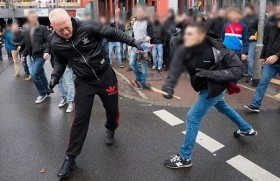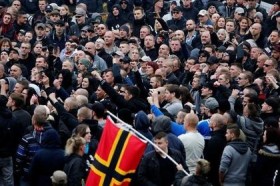Nazi Hooligans Riot in Cologne, Germany
In recent years, October has become a month that means more than just disguised children and glowing Jack-o-lanterns to residents of Cologne, Germany. On Sunday October 25, 2015 the streets of this otherwise friendly and calm city witnessed an undesirable demonstration that turned violent. A mutant-alliance of soccer hooligans and neo-Nazis came together in intoxicated […]
In recent years, October has become a month that means more than just disguised children and glowing Jack-o-lanterns to residents of Cologne, Germany. On Sunday October 25, 2015 the streets of this otherwise friendly and calm city witnessed an undesirable demonstration that turned violent.

A mutant-alliance of soccer hooligans and neo-Nazis came together in intoxicated unity, protesting against foreigners and generally anyone and anything that isn’t pure German. They were not so direct as to express themselves in those words when asking permission from the Cologne government to protest – they needed a political reason to demonstrate and they found one: the growing population of Muslim extremists in Germany known as Salafists.
Salafism is an extremely conservative group of Muslim purists. The movement comes from Sunni Islam. Members reference the doctrine of Salafism, which rejects any religious deviation from Islamic law. This is one of Germany’s biggest security threats with roughly 45,000 Salafist members throughout the country. Their main goal is to replace democracies worldwide with Islamic government based on Sharia Law. Germans across the country fear this concept, giving the neo-Nazis and hooligans the political leverage that they needed to be publically accepted.
The band of soccer hooligans and neo-Nazis go by the name of Hooligans Against Salifists, or HoGeSa. The alliance formed primarily online via social media outlets such as Facebook and private forums. The group has been steadily increasing in members every year. The German population and government are concerned about what this might mean for German racial tensions that seem to grow with each passing year.
The HoGeSa demonstrators were given permission to demonstrate on, but not through the streets of Cologne. They were met with counter-demonstrators, some protesting against the racial fundamentals fueling the group’s agenda, while others were actual Salafist members, and others were simply foreigners or Muslims with non-extremist agendas. The HoGeSa chanted, ‘’No more foreigners’’ in between politically unacceptable racial slurs. As the day wore on, demonstrators became more intoxicated and more aggressive.
Thousands of riot police as well as ordinary law enforcement were deployed in anticipation of outbursts from the demonstrators. October 2014 was met with nearly 50 injured officers and an overturned police van as drunken members from both sides began throwing glass bottles and other projectiles. Law enforcement administered pepper spray, dogs, batons, and water in an attempt to subdue the crowd. October 2015 was met with much the same outcome: 49 injured officers, an overturned police van (a HoGeSa tradition, it would seem), and thousands of intoxicated hooligans looking for an excuse to act out in public.
Hooligans will be hooligans, but Nazis will be insidious. The alliance is unholy, no matter how you analyze it. The organization is no doubt coming from the side of the neo-Nazis, the growth of which has been both a European and American fear since the end of WWII. When the war ended, there were countless unprosecuted Nazis roaming the streets of Germany, many of whom served as high-ranking officers, just waiting for their chance to continue Hitler’s Nazi ideology. These men went on to infiltrate prominent government offices in Germany and throughout other parts of Europe. The Allied forces wanted to put a stop to any future formation of Nazi groups; however the rise of the Cold War made potential Nazi activity a background priority.
Germany finally saw the fall of the Berlin Wall in 1989, with social readjustment continuing through the 1990s. Former Nazis seized this opportunity to convince degenerate youths from former East Germany to join their cause against anything foreign or threatening to their ‘’Fatherland.’’ Since then, Nazi activity has not been outlawed in Germany, as in some other parts of Europe. However, Holocaust denial and public admiration of Hitler and his Nazi views are forbidden throughout Germany, with Munich being the city with the least amount of tolerance for any Hitler-related activity.
Since direct association to Hitler and his soldiers is forbidden by law, neo-Nazis have stayed relatively inactive, waiting for a political reason such as the rise of Muslim extremists in Germany to come forward with an indirect purpose to spread their hatred. The common fear against Muslim extremists has brought a consistent flow of new members to HoGeSa. This is their current target for politically-grounded activity, but the general fear is that it will not stop there. Like Hitler, these members do not want any outside presence permanently influencing German culture and politics.
Knowing that they are largely outnumbered, these far-right thinkers refrain from expressing their opinions in public, especially when they are not in a large group. Cologne is one of the most foreign- and homosexual-friendly cities in Germany, often referred to by locals as ‘’Germany’s best kept secret.’’ This is why tensions were high among Cologne’s foreign population, myself included. This is currently the one day of the year that neo-Nazis and other self-proclaimed racists have no qualm in publically expressing their intolerance.
Foreign coworkers of mine were nothing short of nervous the day before the demonstration. Memories of harassment from the previous year’s demonstration were fresh in their minds. I was shocked to learn that such activity even occurred in Cologne, as opposed to some of the infamously racist regions of Germany, such as in the south. But bridges were closed, people chanted angrily en masse, subway lines were either down or stalled, and police officers littered the streets. Until this day, I knew only one side of Cologne: easygoing, diverse, and tolerant.
Politics are by nature ambiguous, polluted with more ‘’grey area’’ than is ideal. That is due to the complex diversity of the human mind; there is absolutely no sure-fire solution that meets everyone’s opinions and religious beliefs. This is where extreme views come into play, finding it easier to wipe out any ‘’what if’’ or ‘’but’’ possibilities from the argument. A solution to assure human security across the globe against threats related to Muslim extremism has not been found. Groups such as the HoGeSa have thus taken the matter into their own hands in an attempt to force political leaders in Germany, and throughout the world, to do something about the potential threat before it’s too late. Unfortunately, their message was not heard so clearly as members chose to use the demonstration to promote their intolerance against foreigners in general rather than Salafist members. Based on the last few violent demonstrations, next year’s demonstration will likely be met with heavier security and restrictions or not allowed at all.
Jacqueline Perrier-Gillette is currently a resident of Paris, France, where she lives with her husband. Together the two of them operate their small translation company, giving Jacqueline the opportunity to observe the French and their culture up close. She is an avid reader, writer, and student of foreign languages.
By Jacqueline Perrier-Gillette







